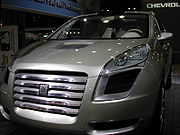
General Motors Sequel
Encyclopedia

Hydrogen
Hydrogen is the chemical element with atomic number 1. It is represented by the symbol H. With an average atomic weight of , hydrogen is the lightest and most abundant chemical element, constituting roughly 75% of the Universe's chemical elemental mass. Stars in the main sequence are mainly...
fuel cell
Fuel cell
A fuel cell is a device that converts the chemical energy from a fuel into electricity through a chemical reaction with oxygen or another oxidizing agent. Hydrogen is the most common fuel, but hydrocarbons such as natural gas and alcohols like methanol are sometimes used...
-powered
Power (physics)
In physics, power is the rate at which energy is transferred, used, or transformed. For example, the rate at which a light bulb transforms electrical energy into heat and light is measured in watts—the more wattage, the more power, or equivalently the more electrical energy is used per unit...
concept car
Concept car
A concept vehicle or show vehicle is a car made to showcase new styling and or new technology. They are often shown at motor shows to gauge customer reaction to new and radical designs which may or may not have a chance of being produced....
and sport utility vehicle
Sport utility vehicle
A sport utility vehicle is a generic marketing term for a vehicle similar to a station wagon, but built on a light-truck chassis. It is usually equipped with four-wheel drive for on- or off-road ability, and with some pretension or ability to be used as an off-road vehicle. Not all four-wheel...
from General Motors, employing the latest generation of HydroGen3
HydroGen3
HydroGen3 is an Opel hydrogen fuel cell vehicle used for testing. HydroGen3’s driving range is the highest of any fuel cell vehicle approved for public roads in Japan.-Technical specifications:...
technology developed by Opel
Opel
Adam Opel AG, generally shortened to Opel, is a German automobile company founded by Adam Opel in 1862. Opel has been building automobiles since 1899, and became an Aktiengesellschaft in 1929...
. The Sequel uses a "skateboard chassis" in which all relevant drivetrain and 700 bar hydrogen storage components are integrated. In addition a sophisticated drive-by-wire system
System
System is a set of interacting or interdependent components forming an integrated whole....
is implemented. It has a range of greater than 300 miles, demonstrated on public roads between Rochester and New York City in March 2007. Its only emission is water.
GM announced September 11, 2006 that their Sequel all-wheel drive fuel-cell vehicle will be a Chevrolet
Chevrolet
Chevrolet , also known as Chevy , is a brand of vehicle produced by General Motors Company . Founded by Louis Chevrolet and ousted GM founder William C. Durant on November 3, 1911, General Motors acquired Chevrolet in 1918...
. The next-generation hydrogen car was unveiled at the Detroit auto show in 2005 and at that time was called the “GM Sequel;” the redesigned version of the crossover was unveiled by Larry Burns, GM’s vice president in charge of R&D and product planning.
The Sequel's fuel-cell stack has a rated power output of 73 kW (98 hp), supplemented by a lithium-ion battery pack rated at 65 kW. One 65 kW electric motor drives the front wheels and individual 25 kW wheel-motors (outboard of the rear brakes) drive each rear wheel, providing total tractive power of 115 kW. Hence,the vehicle can accelerate 0-60 mph in less than ten seconds. Additionally, it provides a high level of control on bumpy terrain, snow, and ice. Increased torque
Torque
Torque, moment or moment of force , is the tendency of a force to rotate an object about an axis, fulcrum, or pivot. Just as a force is a push or a pull, a torque can be thought of as a twist....
and quicker deceleration when braking are additional benefits of some of the new technologies used in the Sequel.
Hydrogen storage and, consequently, driving range are major challenges in the development of fuel-cell vehicles. The Sequel stores 8 kg of gaseous hydrogen in three cylindrical, carbon-composite fuel tanks, pressurized to 700 bar (10,000 p.s.i.) and mounted longitudinally beneath the cabin floor. That is sufficient to provide an unprecedented range of more than 300 miles (480 km) between fill-ups, in spite of the vehicle's considerable 2,170-kilogram mass and large dimensions: The Sequel is just short of five-metres long (4994 mm), and uses an exceptionally long (3040 mm) wheelbase.
External Sources
- http://www.autoblog.com/entry/1234000307026540/
- Fahey, J. "GM's wild gamble." In Forbes #175, 25 April 2005, pp. 78–83.
- "The Architect behind the Reinvention of the Automobile"
- General Motors Hy-wireGeneral Motors Hy-wireThe Hy-wire is a concept car from General Motors originally introduced in January 2002. The car runs on hydrogen fuel cells and uses a drive-by-wire system, meaning that the car is controlled electronically...
- Zero-emissions vehicleZero-emissions vehicleA zero-emissions vehicle, or ZEV, is a vehicle that emits no tailpipe pollutants from the onboard source of power. Harmful pollutants to the health and the environment include particulates , hydrocarbons, carbon monoxide, ozone, lead, and various oxides of nitrogen. Although not considered emission...

